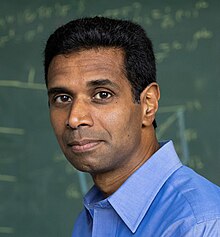Chetan Nayak (born 1971) is an American physicist and computer scientist specializing in quantum computing. He is a professor at the University of California, Santa Barbara and a technical fellow and distinguished engineer on the Microsoft Azure Quantum hardware team.[4] He joined Microsoft in 2005 and became director and general manager of Quantum Hardware at Microsoft Station Q at Microsoft Research in 2014.[5][6][7]
Chetan Nayak | |
|---|---|
 | |
| Born | Chetan Nayak New York City, NY, United States |
| Nationality | American |
| Alma mater | |
| Known for |
|
| Awards |
|
| Scientific career | |
| Fields | Quantum computing, Computer Science |
| Institutions | Microsoft |
| Thesis | Theories of the half-filled Landau level [3] (1996) |
| Doctoral advisor | Frank Anthony Wilczek [3] |
Education and career
editNayak was born in New York City in 1971. He earned a bachelor’s degree from Harvard University in 1992 and a Ph.D. in physics from Princeton University in 1996.[5][3] His dissertation on “Theories of the half-filled Landau level” was completed under Frank Anthony Wilczek.[3]
In 1996, he was a post-doctoral fellow at the Institute for Theoretical Physics at UCSB and a Professor of Physics at UCLA from 1997 to 2006.[5][8][9]
He joined Microsoft in 2005 as a visiting researcher in Redmond, Washington and the faculty of UCSB in 2007 where he has served as Technical Fellow and Professor of Condensed Matter Theory through 2024.[5][7][10][11]
Nayak has contributed to the theory of topological phases, high-temperature superconductivity, the quantum Hall effect, and phases of periodically-driven quantum systems.[12][13][14][15][16][11][17][18]
Scientific Work
editIn 1996, Nayak and Wilczek discovered the type of non-Abelian statistics in paired quantum Hall states associated with Majorana zero modes.[16]
In 2005, with Michael Freedman and Sankar Das Sarma, Nayak authored a proposal for a topological qubit using the 5/2 fractional quantum Hall state as the non-Abelian topological state.[14][19]
In 2006 and 2008, Sarma, Freedman and Nayak developed theoretical proposals for topological quantum computing based on non-abelian anyons.[17][11]
In 2011, Nayak, Parsa Bonderson and Victor Gurarie proved that quasiparticles in certain quantized Hall states are non-Abelian anyons, firmly establishing the mathematical foundation of these particles.[12]
In 2016, with Dominic Else and Bela Bauer, he developed Floquet time crystals and predicted its occurrence in periodically-driven systems.[15][18]
Nayak also led research teams in inducing a phase of matter characterized by Majorana zero modes with low enough disorder to pass the topological gap protocol, demonstrating the viability of topological quantum computing. [20]
Recognition
editNayak is a Fellow of the American Physical Society, a recipient of the Outstanding Young Physicist Award from the American Chapter of the Indian Physics Association, an Alfred P. Sloan Foundation Fellowship, and an NSF Early Career Award.[1][2][21][22]
References
edit- ^ a b ""APS Fellowship Division of Condensed Matter Physics Fellowship". American Physical Society. 2011. Retrieved 2024-10-04.
- ^ a b "2000 Annual Report" (PDF). Sloan.org. 2000. Retrieved 2024-10-04.
- ^ a b c d Nayak, Chetan (November 1996). "Theories of the Half-Filled Landau Level". ProQuest. Retrieved 2024-10-04.
- ^ Kelley, Alexandra (8 February 2024). "Microsoft Quantum Coming Getting DARPA Funding". Redmond Channel Partner Magazine. Retrieved 2024-10-04.
- ^ a b c d "Shelly Gable, Chetan Nayak". The New York Times. 20 March 2005. Retrieved 2024-10-04.
- ^ Simonite, Tom (4 November 2019). "Microsoft is Taking Quantum Computers to the Cloud". Wired. Retrieved 2024-10-04.
- ^ a b Savitsky, Zach (20 December 2023). ""A ghostly quasiparticle rooted in a century-old Italian mystery could unlock quantum computing's potential—if only it could be pinned down". Science.org. Retrieved 2024-10-04.
- ^ Gurarie, Victor; Flohr, Michael; Nayak, Chetan (11 August 1997). "The Haldane-Rezayi quantum Hall state and conformal field theory". Nuclear Physics B. 498 (13): 513-538. arXiv:cond-mat/9701212. Bibcode:1997NuPhB.498..513G. doi:10.1016/S0550-3213(97)00351-9. Retrieved 2024-10-04.
- ^ Freedman, Michael; Nayak, Chetan; Walker, Kevin; Wang, Zhenghan (11 August 1997). "A class of P,T-invariant topological phases of interacting electrons" (PDF). Annals of Physics. 310 (2004): 428-492. arXiv:cond-mat/0307511. doi:10.1016/j.aop.2004.01.006. Retrieved 2024-10-04.
- ^ "Condensed Matter Theory". University of California Santa Barbara. Retrieved 2024-10-04.
- ^ a b c Nayak, Chetan; Simon, Steven; Stern, Ady; Freedman, Michael; Das Sarma, Sankar (2008). ""Non-Abelian anyons and topological quantum computation". Reviews of Modern Physics. 80 (3): 1083. arXiv:0707.1889. Bibcode:2008RvMP...80.1083N. doi:10.1103/RevModPhys.80.1083. Retrieved 2024-10-04.
- ^ a b Wilczek, Frank (11 February 2011). "A landmark proof". Physics. 4: 10. arXiv:1008.5194. doi:10.1103/PhysRevB.83.075303. Retrieved 2024-10-04.
- ^ Moore, Joel (5 October 2009). "Quasiparticles do the twist". Physics. 2: 82. doi:10.1103/PhysRevB.80.155303. Retrieved 2024-10-04.
- ^ a b Markoff, John (23 June 2014). "Microsoft Makes Bet Quantum Computing is Next Breakthrough". The New York Times. Retrieved 2024-10-04.
- ^ a b Zyga, Lisa (9 September 2016). "Time crystals might exist after all". Phys.org. Retrieved 2024-10-04.
- ^ a b Nayak, Chetan; Wilczek, Frank (18 November 1996). "2n-quasihole states realize 2n−1-dimensional spinor braiding statistics in paired quantum Hall states". Nuclear Physics B. 479 (3): 529-553. arXiv:cond-mat/9605145. doi:10.1016/0550-3213(96)00430-0. Retrieved 2024-10-04.
- ^ a b Das Sarma, Sankar; Freedman, Michael; Nayak, Chetan (1 July 2006). [hhttps://pubs.aip.org/physicstoday/article-abstract/59/7/32/1040851/Topological-quantum-computationThe-search-for-a?redirectedFrom=fulltext "Topological Quantum Computation"]. Physics Today. 59 (7): 32-28. Bibcode:2006PhT....59g..32S. doi:10.1063/1.2337825. Retrieved 2024-10-04.
- ^ a b Else, Dominic; Bauer, Bela; Nayak, Chetan (26 August 2016). "Floquet Time Crystals". Physical Review Letters. 117 (9): 090402. arXiv:1603.08001. Bibcode:2016PhRvL.117i0402E. doi:10.1103/PhysRevLett.117.090402. PMID 27610834. Retrieved 2024-10-04.
- ^ Das Sarma, Sankar; Freedman, Michael; Nayak, Chetan (27 April 2005). "Topologically Protected Qubits from a Possible Non-Abelian Fractional Quantum Hall State". Physical Review Letters. 94 (16): 166802. arXiv:cond-mat/0412343. doi:10.1103/PhysRevLett.117.090402. PMID 27610834. Retrieved 2024-10-04.
- ^ Yirka, Bob (24 June 2023). "Microsoft claims to have achieved first milestone in creating a reliable and practical quantum computer". Phys.org. Retrieved 2024-10-04.
- ^ "Alfred P. Sloan Foundation Fellows Database". Alfred P. Sloan Foundation. 2000. Retrieved 2024-10-04.
- ^ "Chetan Nayak". Aspen Center for Physics. Retrieved 2024-10-04.
External links
edit- Chetan Nayak publications indexed by Google Scholar